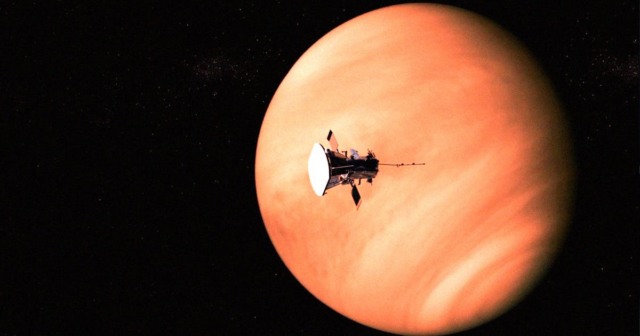NASA’s Parker Solar Probe Discovers Radio Signal Coming From Venus. This is how ‘The Expanse’ happens, folks!

Looks like we got ourselves a motherfucking protomolecule situation, friends. Okay, aiight. It’s definitely not that shit, but it’s still wild. You see, NASA’s Parker Solar Probe has discovered a radio signal coming from Venus. Like, holy fuck.
Science Alert:
During a close flyby of the planet Venus in July 2020, NASA’s Parker Solar Probe detected something odd.
As it dipped just 833 kilometers (517 miles) above the Venusian surface, the probe’s instruments recorded a low-frequency radio signal – a telltale sign that Parker had skimmed through the ionosphere, a layer of the planet’s upper atmosphere.
This was the first time an instrument had been able to record direct in situ measurements of Venus’ upper atmosphere in nearly three decades, and the data recorded gives us a new understanding of how Venus changes in response to cyclic changes in the Sun.
“I was just so excited to have new data from Venus,” said astronomer Glyn Collinson of NASA’s Goddard Space Flight Center.
Venus is a fascinating world to us here on Earth. It’s so similar to our own planet in size and composition, but so crucially different: a toxic, scorching hot hell-world that is likely completely inhospitable to life as we know it.
How the two planets could have developed into such radically different beasts is of deep interest to planetary scientists and astrobiologists searching for other habitable worlds out there in the Milky Way.
Yet missions to explore Venus have been relatively few. There’s not much point sending landers; they can’t survive the planet’s 462 degree Celsius (864 degree Fahrenheit) surface.
Sending orbiting probes is also considered problematic, due to the incredibly thick atmosphere of carbon dioxide and sulfuric acid rain clouds that make it hard to tell what’s happening on the surface.
For these reasons, Venus hasn’t been a popular target for dedicated missions in some time (Japan’s Akatsuki orbiter being the recent exception), and a lot of our recent data has come piecemeal, from instruments with other primary objectives, like the Parker Solar Probe.
As Parker conducts its mission to study the Sun in close detail, it’s been using Venus for gravity assist maneuvers – slingshotting around the planet to alter velocity and trajectory. It was on one of these gravity assist flybys that the probe’s instruments recorded a radio signal.
Collinson, who has worked on other planetary missions, noted an odd familiarity that he couldn’t quite place in the shape of the signal.
“Then the next day, I woke up,” he said. “And I thought, ‘Oh my god, I know what this is!'”
It was the same kind of signal recorded by the Galileo probe when it skimmed through the ionospheres of Jupiter’s moons – a layer of atmosphere, also seen on Earth and Mars, where solar radiation ionizes the atoms, resulting in a charged plasma that produces low-frequency radio emission.
Once the researchers realized what the signal was, they were able to use it to calculate the density of the Venusian ionosphere, and compare it to the last direct measurements taken, all the way back in 1992. Fascinatingly, the ionosphere was an order of magnitude thinner in the new measurements than it was in 1992.
The team believes that this has something to do with solar cycles. Every 11 years, the Sun’s poles swap places; south becomes north and north becomes south. It’s not clear what drives these cycles, but we do know that the poles switch when the magnetic field is at its weakest.
Because the Sun’s magnetic field controls its activity – such as sunspots (temporary regions of strong magnetic fields), solar flares, and coronal mass ejections (produced by magnetic field lines snapping and reconnecting) – this stage of the cycle manifests as a period of very minimal activity. It’s called the solar minimum.
Once the poles have switched, the magnetic field strengthens, and solar activity rises to a solar maximum before subsiding again for the next polar switch.
Measurements of Venus from Earth suggested that Venus’ ionosphere was changing in sync with the solar cycles, growing thicker at solar maximum and thinner at solar minimum. But without direct measurements, it was difficult to confirm.
Well, guess what? The 1992 measurement was taken at a time close to solar maximum; the 2020 measurement close to solar minimum. They were both consistent with the Earth-based measurements.
“When multiple missions are confirming the same result, one after the other, that gives you a lot of confidence that the thinning is real,” said astronomer Robin Ramstad of the University of Colorado, Boulder.
Exactly why the solar cycle has this effect on Venus’ ionosphere is unclear, but there are two leading theories.
The first is that the upper boundary of the ionosphere could be compressed to a lower altitude during solar minimum, which prevents atoms ionized on the day side from flowing to the night side, resulting in a thinner night side ionosphere. The second is that the ionosphere leaks into space at a faster rate during solar minimum.
Neither of these mechanisms could be ruled out by the Parker data, but the team hopes that future missions and observations might be able to clarify what’s going on. In turn, that could help us gain a better understanding of why Venus is the way it is, compared to Earth.
Maybe it’s about time for another Venus mission, eh?



